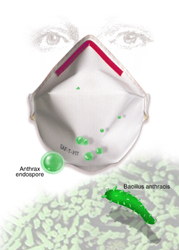
A particulate respirator mask can easily filter out Anthrax endospores. (illustration by Dominic Doyle)
Anthrax explained
Here are answers to questions most often asked about this microbe:
Q: What does anthrax look like?
A: In its most destructive form — an aerosol sprayed into the air — it is invisible and odorless. Anthrax spores can only be seen through a microscope that magnifies 50 to 100 times. Scientists say it can be stored in bulk as a powder, liquid or paste.
Q: Would I know if I breathed anthrax?
A: No.
Q: If anthrax is on the ground, can I get it from kicking up dust?
A: Probably not. The spores tend to clump together, so even if inhaled, they do not get deep into the lungs.
Q: How much anthrax does it take to make someone sick?
A: Roughly 10,000 spores.
Q: Where do anthrax spores come from?
A: Anthrax bacteria live in the blood of animals. When an animal dies, the bacteria form spores, which are released.
Q: What happens when a person breathes them?
A: The spores become lodged in the lungs. There, they are picked up by immune-system cells called macrophages, which carry them to the lymph nodes. On the way, the spores mature into bacteria.
Q: How do they make people sick?
A: The bacteria multiply in the lymph nodes and then enter the bloodstream. They produce a poison that causes the immune system to produce lethal doses of chemicals that are ordinarily useful to the body.
Q: What are the symptoms?
A: At first, they seem like a cold or flu: fever, ache and nonproductive cough. Plummeting blood pressure, swelling, hemorrhaging and other catastrophic symptoms soon follow.
Q: How quickly can it kill?
A: Typically within three days of the start of symptoms.
Q: How soon do symptoms start once people breathe the spores?
A: Usually around 10 days, but up to six weeks.
Q: Can it be treated?
A: It can be treated with antibiotics, such as Cipro or doxycycline, if given before symptoms start. Treatment usually fails once symptoms set in, since it does no good to kill the bacteria once they make large amounts of toxin.













